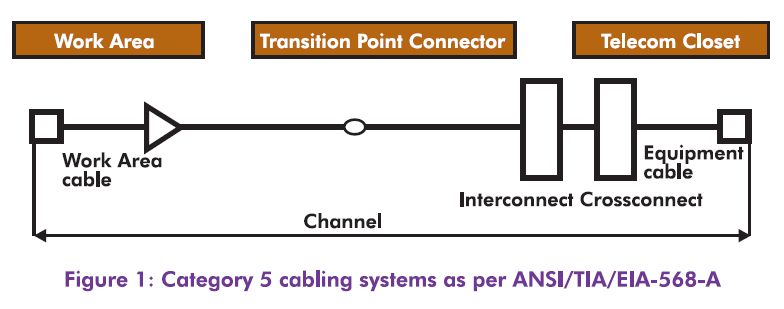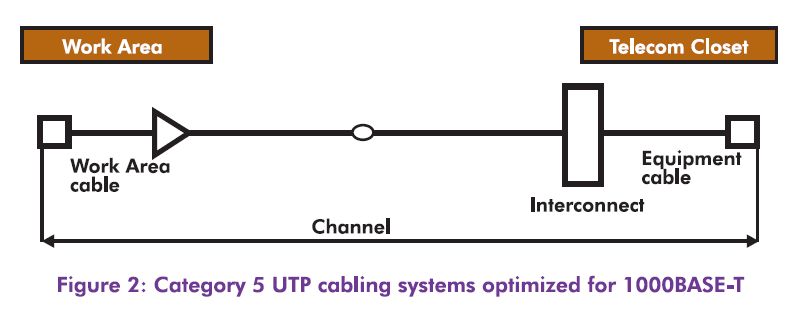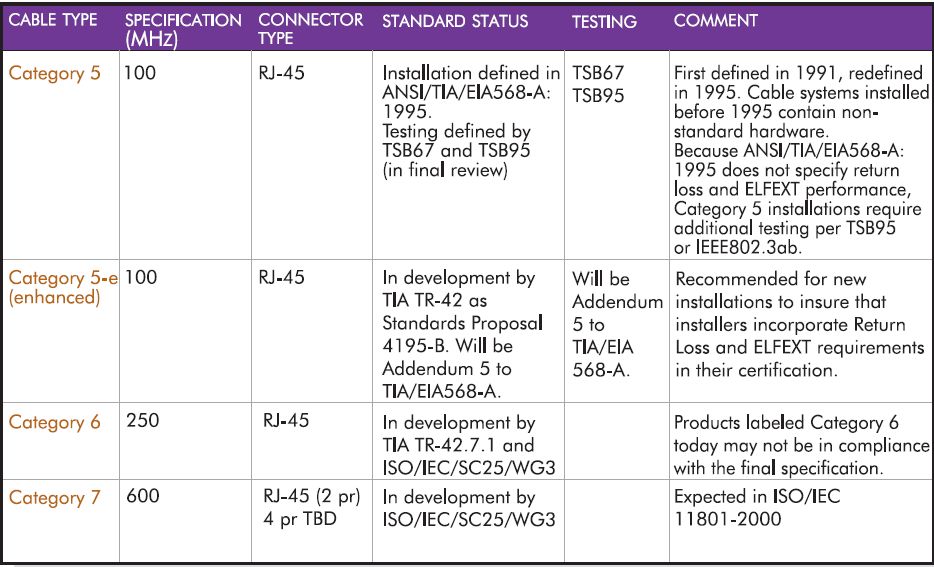Table Of Contents
- INTRODUCTION
- 1000BASE-T AND CATEGORY 5 CABLING
- QUALIFYING CATEGORY 5 CABLING
- ASSESSING THE RISK
- SPECIFICATIONS FOR NEW INSTALLATIONS
- TOPOLOGY RULES
- CABLING SYSTEMS: CATEGORY 5, ENHANCED CATEGORY 5,CATEGORY 6, CATEGORY 7
- THE IMPORTANCE OF CHOOSING A STRONG CABLING PARTNER
- CONCLUSION
- DEFINITIONS OF TERMS USED
1000BASE-T - running Gigabit Ethernet over Copper
INTRODUCTION
When network managers decide on a cabling system, they make a decision that is basic to the network infrastructure and long term in its horizon. With the ratification of 1000BASE-T in June 1999 (IEEE 802.3 Ethernet Standard for Gigabit Ethernet on Category 5 copper), network managers are asking hard questions about this technology because they want to future proof their network infrastructures. Most of the cabling installed today inside buildings is Category 5. While 1000BASE-T will run over Category 6 cabling, migration of the installed base of Category 5 to higher speed Ethernet is the primary focus of the IEEE 1000BASE-T Standard. While networking equipment can easily be pulled from a rack, horizontal cabling can be very difficult to replace since it is located inside a wall, ceiling, or raised floor and dispersed across many wiring closets. Various copper and fiber choices are available on the market today. This document addresses directly the questions about Gigabit Ethernet operation over the installed base of Category 5 cabling.
1000BASE-T AND CATEGORY 5 CABLING
Network managers and planners will be able to run 1000BASE-T over Category 5 cabling. The IEEE has written the 1000BASE-T Standard for Gigabit Ethernet operation over the Category 5 cabling systems installed according to the specifications of ANSI/TIA/EIA-568A (1995). Member companies of the GEA have demonstrated 1000BASE-T products operating on Category 5 cabling. There should be no need to replace existing Category 5 cabling to use 1000BASE-T. The primary goal of the IEEE 1000BASE-T Task Force responsible for the development of the 1000BASE-T standard was to support the legacy Category 5 cabling. According to the industry experts that made up the IEEE 1000BASE-T Task Force, any link that is currently using 100BASE-TX should easily support 1000BASE-T.
GIGABIT BANDWIDTH OVER CATEGORY 5 CABLING
Fast Ethernet (100BASE-TX) achieves 100 Mbps operation by sending three-level binary encoded symbols
across the link at 125 Mbaud. (A 125 Mbaud symbol rate is required because 100BASE-TX uses 4B/5B coding.)
100BASE-TX uses two pairs: one for transmit, one for receive. The next step up in speed, 1000BASE-T also
uses a symbol rate of 125 Mbaud, but it uses all four pairs for the link and a more sophisticated five-level
coding scheme. In addition, 1000BASE-T sends and receives simultaneously on each pair. Combining 5-level
coding and 4 pairs allows 1000BASE-T to send one byte in parallel at each signal pulse. 4 (pairs) X 125
Msymbols/second X 2 bits/symbol = 1Gbps. Of course, it isn’t quite this simple. In addition to moving the
symbols across the link, 1000BASE-T must also deal with the effects of insertion loss and link-induced interference caused
by echo and crosstalk.
QUALIFYING CATEGORY 5 CABLING
In addition to existing performance criteria for Category 5 field testing as specified in ANSI/TIA/EIA TSB67, users planning to use existing Category 5 cabling for 1000BASE-T are advised to test each link for return loss and Equal-Level Far End Crosstalk (ELFEXT) as specified in 1000BASE-T. These tests are also included in ANSI/TIA/EIA TSB95 (currently a draft standard), the Additional Transmission Performance Guidelines for 100 ohm 4-Pair Category 5 cabling.
Return loss is a measure of the reflected energy caused by impedance mismatches in the cabling system. ELFEXT is defined as the measure of the unwanted signal coupling from a transmitter at the near-end into a neighboring pair measured at the far-end relative to the received signal level measured on that same pair. Power sum equal level far end cross talk (PSELFEXT) is a computation of the unwanted signal coupling from multiple transmitters at the near-end into a pair measured at the far-end relative to the received signal level on that same pair. Return loss and ELFEXT have a negligible impact when a Category 5 link is used to carry 10BASE-T signals, but they can significantly affect 1000BASE-T operation. (Return loss and ELFEXT can also affect the operation of 100BASE-TX.) It is just common sense to test for return loss, ELFEXT, and PSELFEXT before using the link for high-speed protocols and to bring the link up to the required level of performance if it is substandard. Basic cable testing information is provided by ANSI/TIA/EIA TSB67- “Transmission Performance Specifications for Field Testing of Twisted Pair Cabling System.” The additional test requirements for
ELFEXT, PSELFEXT, and return loss will be published in ANSI/TIA/EIA TSB95.
TESTING INSTALLED CABLING
Automated return loss and ELFEXT tests are incorporated into the current versions of cable test tools (see list below). These tools will automatically cycle through all tests required to certify links for performance standards (e.g., Category 5, TSB95, Category 5e, etc.) or applications (e.g., 1000BASE-T). To perform the test, you specify the cabling or application test (or test suite) and initiate it. The cable test tool will automatically perform the required suite of tests and return a PASS or FAIL rating. (Before testing, you should verify that the field tester is accurate and operating properly.)
The GEA has identified at least five vendors of hand-held testers: Datacom/Textron, Hewlett Packard/Scope, Fluke, Microtest, and Wavetek. Each of the cable test tools listed below can also be set to perform individual tests. Some cable test tools may provide additional diagnostic capability to help you determine the source of the problem if you get FAIL. When selecting a tester to certify cabling for 1000BASE-T ensure that it will meet the field tester accuracy requirements specified in ANSI/TIA/EIA TSB95.
• Datacom/Textron (www.datacomtech.com) — LANcat® System 6 (with C5e Performance Module)
• Fluke (www.fluke.com/nettools/) — DSP4000
• Hewlett Packard/Scope (www.scope.com) — Wirescope 155
• Microtest (www.microtest.com) — OmniScanner
• Wavetek (www.wavetek.com) — LT8155
You may be able to upgrade existing cable test tools. Upgrade capabilities are vendor specific and we recommend that you check with your cable test tool vendor. If you have in-house cable testers and testing expertise, you should be able to self-test links. You need to make sure that your cable test tool will test for all required 1000BASE-T test parameters (see the list above). If you want to outsource cable testing, most reliable cable installers and consultants provide link testing and certification. You should request certification of links according to ANSI/TIA/EIA TSB67 and 1000BASE-T or, when published, ANSI/TIA/EIA TSB95.
ASSESSING THE RISK
Some network managers might ask what are the odds that Category 5 links in their cable plant won’t pass the return loss and ELFEXT tests. The 1000BASE-T Task Force and the cabling companies estimate that less than 10 percent of the installed base of Category 5 cable was improperly installed, i.e., not in accordance with the installation instructions contained in ANSI/TIA/EIA568-A-95. This improperly installed cable may not support 1000BASE-T. It is also likely that such cable may not support 100BASE-TX. That being said, such substandard links are not a product of the Category 5 cable itself, but most likely a product of the connectors in the link. Solutions to these connector problems are discussed below.
CORRECTING PROBLEM CABLE INSTALLATIONS
Corrective measures are outlined in the 1000BASE-T standard and in this document. Various types of corrective
measures can be applied: switching to high-performance patch cables, reducing the number of connectors in the
link, and reconnectorizing some or all of the connectors in the link. (See Figures 1 and 2 below.)
ANSTI/TIA/EIA TSB95 (Draft)) defines five corrective actions that can be taken to improve return loss and Far-End Crosstalk performance. Before testing you should verify that the field tester is accurate and operatingproperly. The link should be re-tested after each corrective action is implemented.
• Replace the patch cord with a cord constructed from patch cable that meets the Enhanced Category 5 specification.
• If the link has a cross-connect, reconfigure the cross-connect as an interconnect.
• Remove the transition point connector.
• Replace the work area outlet with an outlet that meets the Enhanced Category 5 specification.
• Replace the interconnect with an interconnect that meets the Enhanced Category 5 specification.
SPECIFICATIONS FOR NEW INSTALLATIONS
The GEA recommends that all new cable installations should be Category 5e, which is specified in an addendum (Draft) to ANSI/TIA/EIA568-A-95. Cable system planners wanting extra bandwidth “headroom” might want to consider Category 6, but they should be aware that existing products are pre-standard.
Both Category 5 and Category 5e cabling are specified to 100MHz. The principal difference between Category 5 and Category 5e is that the standard for Category 5e includes performance requirements for return loss and ELFEXT and performance enhancements to Category 5 which will result in additional margin over the worst case 1000BASE-T link requirements. This means that cable installers who certify their Category 5e installations incorporate return loss and ELFEXT performance in their certification. ANSI/TIA/EIA-568A Category 5
installations do not incorporate return loss and ELFEXT performance guarantees. These return loss and ELFEXT measures are specified in 1000BASE-T and will be specified in ANSI/TIA/EIA TSB95 (Draft), which contains additional recommendations for a minimally compliant Category 5 cabling system. A Category 6 cabling standard, specified to 250 MHz, is under development in the ANSI/TIA/EIA TR-42.7.1 Copper Cabling Systems Working Group and in the International Standard Committee ISO/IEC/SC25/WG3.
The benefits of Category 6 to network managers and cable system planners is the greater performance bandwidth “headroom” to accommodate future high-speed technologies. A Category 7 cabling standard, specified to 600 MHz, is under development in the International Standard Committee ISO/IEC/SC25/WG3. Category 7 cable is constructed with individually shielded pairs and with an additional shield over the pairs. Category 7 cabling requires termination to a shielded connector.
1000BASE-T operates today over Category 5 and 5e cabling. 1000BASE-T can also operate on the cabling specified to the current drafts of Category 6 (Draft 5) and Category 7.
TOPOLOGY RULES
Topology rules for 1000BASE-T should be the same as those used for 100BASE-TX. Category 5 link lengths are limited to 100 meters by the TIA/EIA-568-A cabling standard. 1000BASE-T is specified for operation over those link lengths, as is 100BASE-TX. Half-duplex collision domains are similar to 100BASE-TX; however, each halfduplex collision domain can support only one half-duplex repeater.
CABLING SYSTEMS: CATEGORY 5, ENHANCED CATEGORY 5,CATEGORY 6, CATEGORY 7
The Table below summarizes the differences between the balanced cabling systems.
THE IMPORTANCE OF CHOOSING A STRONG CABLING PARTNER
Selection of a reliable, competent cable contractor is very important. It is critical that your contractor be trained to install and test cabling per the current ANSI/TIA/EIA standards. This training and certification is available from individual cable and connector vendors and from BICSI, a telecommunications association. In addition to providing cabling-related training for telecommunications professionals, BICSI provides information and training for end users, including a new course (DD100: Introduction To Voice/Data Cabling Systems) which teaches end users what they need to look for in a contractor.
Contact BICSI at:
BICSI
861- HIDDEN RIVER PARKWAY
TAMPA, FL 33637-1000
VOICE: 800-242-7405 OR 813-979-1991
FAX: 813-971-4311
URL: WWW.BICSI.ORG
CONCLUSION
Only a few years ago many industry experts and pundits claimed that 10 Mbps Ethernet would never operate over twisted pair cabling. Similar claims were made about 100 Mbps Ethernet (Fast Ethernet). Today, these claims are being repeated by various vendors about 1000 Mbps Ethernet (Gigabit Ethernet). Marketing hype aside, GEA member companies have demonstrated 1000BASE-T products over Category 5 cabling. Moreover, the 1000BASE-T Standard specifies Gigabit Ethernet for operation over the installed base of Category 5 cabling.
According to the Ethernet industry experts that made up the IEEE 1000BASE-T Task Force, any link that currently supports 100BASE-TX should easily support 1000BASE-T.
DEFINITIONS OF TERMS USED
- Crosstalk is unwanted signals coupled between adjacent wire pairs. Since 1000BASE-T uses all four wire pairs, each pair is affected by crosstalk from the adjacent three pairs. Crosstalk is characterized in reference to the transmitter.
- Near-end crosstalk (NEXT) is crosstalk that appears at the output of a wire pair at the transmitter (near) end of the cable.
- Far-end crosstalk (FEXT) is a measure of the unwanted signal coupling from a transmitter at the near-end into a neighboring pair measured at the far-end.
- Equal level far-end crosstalk (ELFEXT) is a measure of the unwanted signal coupling from a transmitter at the near-end into a neighboring pair measured at the far-end relative to the received signal level measured on that same pair.
- Power sum equal level far-end crosstalk (PSELFEXT) is a computation of the unwanted signal coupling from multiple transmitters at the near-end into a pair measured at the far-end relative to the received signal level on that same pair.
September 1999
Gigabit Ethernet Alliance
For ethernet over copper broadband services like XO’s 10Mb ethernet over Copper, see the ethernet broadband tool.
Links of interest:
- Ethernet Whitepapers
- USA Business & Carrier Metro Ethernet
- Metro Wave Division Multiplexing, DWDM Services and DWDM/ROADM
- Business Phone Systems (external)
- International WAN & DIA Services
- Wholesale SIP Termination (carrier & enterprise)
If you found this page helpful, please support us by bookmarking us with one of the services below or by linking to this page.
- half duplex
- 1000 base T
- IEEE 802 3 1000baseT
- how to test metro ethernet speed
- how to run wan on three cables
- how does gigabit ethernet work
- gigabit pairs send/receive
- gigabit ethernet signal pair frequency
- gigabit ethernet signal frequency
- gigabit ethernet requires frequcny
No related posts.













